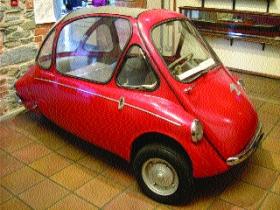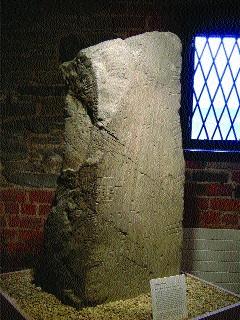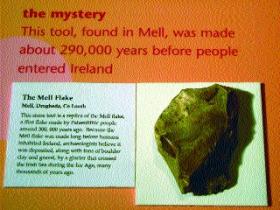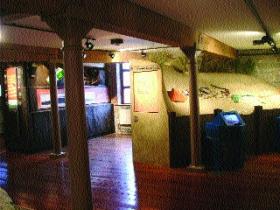Museum Eye
Published in 18th–19th - Century History, Early Modern History (1500–1700), Issue 2 (Mar/Apr 2005), Reviews, Volume 13
A two-seater Heinkel cabin scooter, a rare example of an indigenous Irish car that was manufactured in Dundalk in the 1950s. (Louth County Museum)
Louth County Museum
Jocelyn Street, Dundalk
Monday–Saturday 10.30am–5.30pm
Sunday 2pm–6pm
by Tony Canavan
Located in a renovated warehouse in the heart of Dundalk, since it opened in 1994 the Louth County Museum has won a number of awards, including Museum of the Year in 1995 and 1999. It is also one of the few such institutions to be officially designated as a museum by the Heritage Council. It traces the social, industrial and cultural history of the ‘wee county’ from earliest times. The permanent exhibitions are on three floors, while the top, fourth, floor of the building hosts temporary or visiting exhibitions (the current one on the theme of the Holocaust).
You are greeted by an unusual motor vehicle on the way into the ground-floor exhibition on Dundalk’s industrial legacy. It is a two-seater Heinkel cabin scooter, a rare example of an indigenous Irish car that was manufactured in Dundalk in the 1950s when the Heinkel company switched from building planes for the German war effort to peacetime industries. The rest of this exhibition is a rich display of the town’s old industries, such as milling, textiles, brewing and distilling, footwear and tobacco. One case contains relics of the drinks industry, including a collection of bottle labels, one of which is from the wonderfully named ‘Old Invalid Port’.
It is not just the visual spectacle that hits you as you enter but also the sounds that emanate from the many screens showing videos of various industries. For this innovative museum makes good use of audio-visual tools, which include the conventional films for viewing only as well as interactive screens for exploring subjects in more depth. In the industrial exhibition, for example, there is an entertaining and informative interactive screen about the production and use of energy from the pre-Viking age to modern times. The main feature of this area, though, is the machinery and tools on display. They range from the tools of craftsmen involved in making barrels to machines used in Dundalk’s many factories, such as the peculiar spinning hobby that was used before 1888 to make twist tobacco. The machines are all well labelled and surrounded by illustrated information panels, so that by the time the visitor leaves to go on to the next floor he or she will be an expert on Dundalk’s industries.

Reproduction of an ogham stone, showing the earliest form of Irish writing. (Louth County Museum)
The first floor takes as its theme ‘Boundaries and Borders’ and explores Louth’s social history from the arrival of Christianity. The exhibition on this floor is well laid out and contains a good balance of information and illustrative material alongside the actual historical objects. It includes exhibits on where people lived, the development of the church and political events. You can actually crawl through a replica souterrain, or sit in a twentieth-century parlour watching a TV showing videos of local interest. There are good interactive displays on Monasterboice’s high cross, oral history and other themes. Ogham, the earliest form of Irish writing, gets some attention as there are many stones carved with it in Louth.
Of course, Louth has had its share of warfare, such as the Siege of Drogheda and the Battle of the Boyne. These feature obliquely in the exhibition through a few weapons on display, and more interestingly through a shaving mirror reputed to have belonged to Oliver Cromwell and two items from William of Orange, an army commission he signed in 1673 and a leather jerkin he is said to have worn at the Battle of the Boyne.

Visit the museum and solve the mystery. (Louth County Museum)
The final floor of permanent exhibits concentrates on natural history and archaeology. The natural history section is excellent, covering everything from geology to pollution. There are impressive models showing how a bog is built up and how objects end up on the seashore. The latter has an ingenious system whereby the visitor can pick up an object off the beach, swipe the attached plastic card in a computer and pull up information on it. Beside this there is a display of ‘litter bugs’ made from objects, like cans or cigarette butts, carelessly thrown away.
The section on archaeology is the best that I have seen in explaining the work of the archaeologist and making people think about it. This is achieved by using the words of real archaeologists, showing objects in context and providing a selection of riddles and puzzles to solve. In one display you are presented with descriptions of everyday objects as they might appear to an archaeologist from the future and you have to guess what they are. You then lift up the covers to reveal the objects beneath to see if you are right. This section also has one extremely intriguing puzzle in the form of the Mell flint. This flint tool is over 300,000 years old and pre-dates the arrival of humans in Ireland. How did a man-made tool arrive in Ireland before humans did? To find out the answer, visit the museum.
There is much to recommend about this museum and it is certainly popular with local people. On the day that I was there a party of elderly visitors were being well looked after by the staff. Despite being spread over four floors, mobility is not a problem as there is a lift. For those new to the county, the museum runs an introductory video in its film theatre, which also doubles as a lecture and performance venue. It certainly deserves the accolades it has won.

A view of some of the museum’s galleries. (Louth County Museum)
Tony Canavan is a former Museum Officer of Newry and Mourne District Council.
Last issue’s ‘Museum Eye’ reviewer was Johanne Devlin Trew (not Frew). Apologies to Johanne for the error. (Ed.)
















